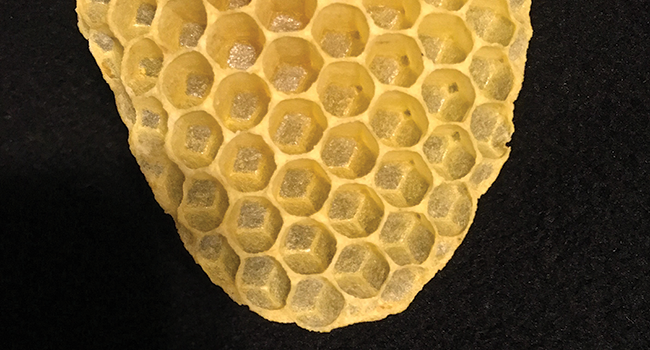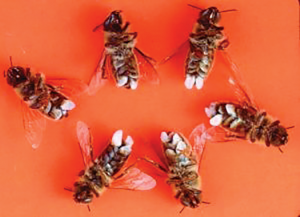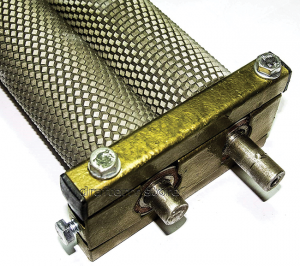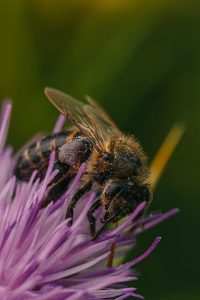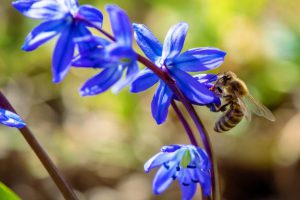By: Peter Borst
How Do They Do This So Well?
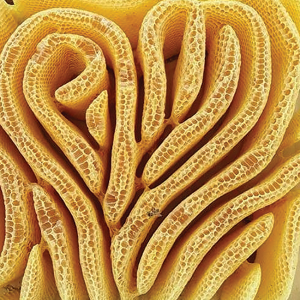 Historical Notes
Historical Notes
Since ancient times, people have marveled at the society and the architecture of the honey bees. The following excerpt from “The Fables of Pilpay” gives a glimpse of the thinking two thousand years ago.
They have a king among them, who is bigger than the rest, and whom they all obey; he resides in a little square apartment, and has his vizirs, his porters, his Serjeants, and his guards; the industry of these, and all his other officers, and people in general, is such, that they frame every one for themselves a little six-cornered chamber of wax, the angles of which differ not at all in shape or dimensions, but are so exactly made to answer one another, that the most expert geometrician could not range them with more regularity (Gaulmin, 1818).
It wasn’t until the 1600s, that Jan Swammerdam established the fact the the big bee is a female, now called the queen. But the marvel of the geometry of the honeycomb has stayed alive in people’s imagination. Mathematicians computed the angles of the cells and Charles Darwin wrote, “the comb of the hive-bee, as far as we can see, is absolutely perfect in economizing labor and wax.”
This became a major puzzle for him to understand how natural selection could have produced the honey bee which appears to have arrived at this complex solution to building the most efficient structure to house not only themselves but their resources of honey and pollen, using only beeswax, which they produce in their own bodies. The explanation that bees rely on divine guidance made more sense to people at the time.
In 1852, William Kirby described bees as those Heaven-instructed mathematicians, who before any geometer could calculate under what form a cell would occupy the least space without diminishing its capacity, and before any chemist existed to discover how wax might be elaborated from vegetable sweets, instructed by the Fountain of Wisdom, had built their hexagonal cells of that pure material, had closed them at the bottom with three rhomboidal pieces, and were enabled, without study, so to construct the opposite story of combs, that each of these rhomboids should form one of those of three opposed cells, thus giving strength to the structure, that in no other place, could have been given to it (Kirby, 1852).
The Geometry of the Cells
Looking at nature, we see the recurrence of geometric shapes, especially the hexagon. Hexagons are notable in geology, such as the six sided pillars of basalt formed by the slow cooling of lava into fantastic rock cliffs, such as “The Devil’s Postpile” in California and “Fingal’s Cave” in Scotland. More ephemeral, but equally enchanting, are the intricate structures made by aggregates of bubbles. Bubbles, as we all know, form spheres out of the tenuous soapy water membranes. When they are piled up, the surfaces where they touch each other become flat. If the bubbles are nearly the same size, they form neat piles of hexagons.
Further, when multiple bubbles intersect, shapes arise that are very similar to the intersection of cells at the midrib of the bees’ comb. Early observers moved past the study of the hexagons to the base of the comb, which consists of equally sized diamonds, or more correctly – rhombs. From “The Garden of Cyrus”:
And the Combes themselves so regularly contrived that their Mutual Intersections make three Lozenges at the Bottom of every Cell; which severally regarded make three Rows of neat Rhomboidall Figures, connected at the Angles, and so continue three several Chains throughout the whole Comb (Browne, 1736).
While it’s plain enough that a hexagon must contain six equal angles of 120° each, the angles of the little rhombs are a bit more difficult to predict. Early observers found the angles are 110° and 70°. If the larger angle was 120°, the shape of the base would be flat, like manmade honeycomb structures such as cardboard panels. A much smaller value would increase the depth of the cells. But with the bees, the base forms a shallow three-sided pyramid shape that shares its rhombs with three cells on the other side of the comb.
Why this should be so can easily be explained by physics and mathematics, but how did the bees hit upon this shape and replicate it so faithfully for millions of years? A clue lies in the cells of other species of bees and wasps. Solitary Hymenoptera make single cells out of various materials such as leaves or mud, in which to place a single egg. When bees and wasps congregate, they make nests consisting of many cells. With the bumble bee, we find piles of small waxen spheres used for storing honey and raising the young.
More organized bees such as the stingless bees (Melipona) build elaborate combs, which superficially resemble honey bee combs but with important differences. These bees, and also wasps, make combs with the cells pointing only downward, the comb is not two sided. Looking only at the bases, we see half spheres being used, like groups of bubbles. On the undersides the cells are tightly packed, in the familiar hexagonal rows.
Physicists Step Into It
More recently, a group of scientists theorized that the shape of the honey bee comb is accidental and that honey bees are actually trying to make round bottomed cylinders out of wax. In the hot environment of the the hive, the wax melts and flows into the shapes we see, the same way that bubbles or other fluids organize into geometric shapes.
It certainly cannot be the case with wasps, which make their cells out of paper formed from collected plant fibers. They begin with one hexagonal round bottomed cell and surround it with many more of the same until the comb reaches a certain size. Then they build a parallel comb beneath the first and surround the whole thing with an outer shell of paper. This material is never liquid and hexagons are built from the start.
Responding to the idea that the wax becomes fluid in the hive, other researchers took accurate measurements of the internal temperatures, and concluded that they never reach those necessary for wax to flow. Not only that, but it’s pretty obvious that if they did the wax would melt and the comb would fall apart. Sometimes theory gets too far removed from observation.
There was quite a controversy, generating papers such as “Honeybee combs: construction through a liquid equilibrium process?” in 2004, which asserted that “the comb structure is a result of a thermoplastic wax reaching a liquid equilibrium.” This was followed in 2012 by “Hexagonal comb cells of honeybees are not produced via a liquid equilibrium process” which countered: “the geometry of the developing cells is generated by mechanical shaping and not by the self-organised process postulated by the liquid equilibrium hypothesis.”
The Observations of Huber
François Huber may have been blind, but his study of the comb building behavior of honey bees is without doubt the most painstaking, clear and definitive, despite being carried out two hundred years ago. He began using glass walled hives to scrutinize the internal workings of the hive, employing a trusted and able assistant upon whose eyesight he depended. Being frustrated by the fact that bees generally obscure the view of the comb building, he invented a frame hive which allowed the entire inside of the colony to be observed in real time.
With this access, he could gently brush the bees off the combs they were constructing and study their progress over hours and days by returning to the same comb over time. In 1821 he published “New Observations on the Natural History of Bees,” in which he described comb construction in marvelous and complete detail. His work can be easily verified by anyone with a hive of bees and adequate patience. In his words:
The cells of bees consist of two parts, a prismatic hexagonal tube, and a pyramidal bottom. The latter, which must be considered to be most delicate and essential part of the work, is composed of three equal lozenges, similar, uniting in a common centre, and forming a slight cavity by their reciprocal inclination. Their depression into one face of the comb makes a projection on the other, there corresponding to three cells partially common to the whole (Huber, 1821).
The Building of the Combs
Using details from Huber and others, we know that the procedure for building the combs commences when worker bees form a curtain or “festoon,” either by clinging to the top of the cavity in which they find themselves, or the underside of a wooden bar provided by a beekeeper, or else the lower edge of a previously constructed comb. Each row of bees clings tightly to the one above and they face each other, with the aim of building a two sided comb between themselves. Once the comb is commenced they can hang on it. Wax producing bees engorge with honey and the wax forms in glands in their abdomen. The pure beeswax appears in the form of a “scale” or flake, which they take up with their mandibles and begin to chew it like a piece of gum, adding saliva.
This is the very point at which we can see if the bees make cylinders which then morph themselves spontaneously into prisms. The first shapes to appear are all flat, thin supports built down from the top and are inflected at precisely the correct angles from the very start. It looks as if the bees are working from some sort of a blueprint which contains the shapes, angles and distances. But soon it becomes apparent from close observation that no individual bee works for long on the project. They move here and there, starting some work and continuing that started by others. It seems clear that they simply assess the situation in progress, continue as appropriate, and scurry off.
Blueprint or Stigmergy?
The concept of stigmergy was developed by French zoologist Pierre-Paul Grassé about 1959. This idea proposes that there is not a blueprint or overall design at all. It proposes that each bee works independently, responding with a set of reflexive rules which are a sort of “if this, then this” procedure. Computer programmers used the acronym IFTTT; they create branching sequences of procedures that follow one after the other creating an emergent result based on the variable input.
This model can account for why the comb can be constructed in such consistently repeated symmetry when the space is unobstructed, such as inside the wall of a house. Bees can construct combs many feet tall or wide that are perfectly flat and made up of unbroken swaths of hexagons. However, as the need arises, they can change the direction of the comb, winding it to fit irregular spaces, around obstructions, etc. They have the capacity to improvise as needed and to create novel and unexpected shapes and solutions. They do not proceed mechanistically and blindly like a train on the rails, but adjust themselves to whatever space they have occupied.
Stigmergy further supposes that honey bees are not really coöperating in the way that people tend to romanticize that they do. It suggests that each bees is working independently, not really cognizant of the whole structure, or “purpose” of the hive. The great form that we see and admire is the result of thousands of workers proceeding independently, guided by behaviors that have led to success in the past, and have been preserved through time by evolution, which tends to keep successful adaptations while sacrificing those creatures which fail to adapt. Oldroyd and Pratt describe it like this:
Close observation of honey bees shows that each cell emerges from small contributions by many workers rapidly coming and going at the building site. Stigmergy allows any worker to pick up where the last one left off, as long as every worker follows the same rules (Oldroyd, 2015).
Darwin’s Conundrum
Charles Darwin took many years to construct his theory of evolution by natural selection. During this time he challenged himself by looking beyond the apparent results that evolution had produced, to the obstacles his theory would have to overcome to be fully explanatory. One of these was the honeycomb, which had always been seen as an example of the expression of God’s plan by His creatures.
Not only did Darwin intend to challenge this firmly entrenched system of beliefs, but he needed to supplant it with a new system in which people could believe, if it offered a sufficiently strong explanation. In his own words, “I am half mad on the subject to try to make out some simple steps from which all the wondrous angles may result.” According to Sarah Davis:
In the Origin, Darwin wanted to show that simple, repeated actions, such as the excavation of excess wax, could result in complicated structures. This is a lesson that applied not only to honey bees, but also to other creatures’ structures, such as spiders’ webs, birds’ nests and beavers’ dams. The message from Darwin was that instinct could result in seemingly intelligent actions and behaviour, despite the animal not actually reasoning about what it is doing (Davis, 2004).
In order to obtain firsthand observations of honey bees, Darwin made friends with William Tegetmeier, who was an experienced apiarist. They corresponded regularly between 1855 and 1881; Darwin’s son Francis remarked that his father had full trust and respect in the judgement and knowledge of Tegetmeier. Many of the observations were made at the “Experimental Bee House for exhibiting the working of scientific and improved hives” operated in the 1860s by the Apiarian Society of London. It contained numerous glass walled hives so that bees could be observed regardless of the weather outside.
Darwin cited Tegetmeier in his book when he discussed the economy of wax production. Tegetmeier told him that nectar is seldom abundant and that great quantities of it are required to produce small amounts of beeswax. As much as twelve to fifteen pounds of dry sugar would be converted into one pound of wax, he said. Further, even greater quantities would be needed for winter consumption, so there was a strong incentive to use as little nectar as possible to make wax and also to store it in a structure which has the strength and integrity to support the weight of the honey and the bees, which cling to the combs.
Reinforcements
Pure fresh beeswax has great tensile strength, but over time the combs are modified in ways that greatly increases it. Referring again to Huber, he described in detail how the bees gather propolis, which is sap and resins from certain trees, and apply it to the surface of the completed combs. Much attention has been paid to the antiseptic properties of propolis and no doubt the colony benefits from that, but it appears that the chief virtue of it is that it can be used to improve the wax.
Propolis requires much less energy to produce, having only to be gathered and applied where needed. They use it as a sort of varnish, not only on the combs but on all the interior surfaces of the hive. Sometimes they build great structures such as entrance reducers, making the opening to the hive much smaller and easier to guard. Many new beekeepers are concerned by the darkening of the fresh white wax, which over time becomes yellowed, brown and finally dark black. This is mainly caused by the propolizing of the combs. Eventually, the combs become very tough and durable, much less prone to breaking than newly built combs.
The field of beekeeping was revolutionized by the invention by Langstroth of a practical bee hive consisting of boxes fitted with moveable frames in which the bees are induced to build their combs. This was quickly followed by two other revolutionary inventions: the centrifugal honey extractor and honeycomb foundation. While tough old combs could have the honey spun out them using the new machine without damage, new combs were tender and often broke apart in the machine.
The solution was the manufacture of honeycomb foundation, sheets of pure beeswax imprinted with cell bases, that could be mounted in the wooden frames and reinforced with wire. Combs built upon this foundation had the added advantage of being less liable to sag over years of use, although they did tend to stretch and buckle eventually. This fact kept inventors working for a century, trying all sorts of so-called improvements including laminating the beeswax on both sides of a sheet of paper. In the 1920s, the bee magazines were abuzz with talk about bee combs made of aluminum. From the journal “The Western Honey Bee,” April 1922:
These combs present a number of advantages which will appeal to any beekeeper. Drones are effectively controlled. Danger from destruction of combs by wax moth is eliminated. Melting down of combs is rendered impossible. These combs will not break or “buckle” in the extractor, and because the baskets can be revolved more vigorously, they can be extracted much more cleanly (Biggs, 1922).
Aluminum combs proved to be a short-lived fad, I couldn’t find any references to them after 1930. But that didn’t stop the inventors, by the 1960s you could purchase foundation that had embedded wires, or laminated with plastic film.
Finally, in 1971 Paul Pierce patented an entire frame and foundation manufactured out of hard plastic. These days the most popular configuration is a traditional wood frame fitted with a hard plastic comb base, which is lightly sprayed with beeswax coating to make it more acceptable to the honey bees. They faithfully build their comb upon this sturdy foundation, making it nearly indestructible and useful for many decades.
Parting Words
I would like to conclude with the words of Anna Comstock – who in 1908 became the first female assistant professor at Cornell University – from her “Handbook of Nature-study:”
Some have tried to detract from bee skill, by stating that the six-sided cell is simply the result of crowding cells together. Perhaps this was the remote origin of the hexagonal cell; but if we watch a bee build her comb, we find that she begins with a base laid out in triangular pyramids, on either side of which she builds out six-sided cells. A cell just begun, is as distinctly six-sided as when completed (Comstock, 1918).
Questions or suggestions? Write me at peterlborst1@icloud.com
Works Cited
Bauer, D., & Bienefeld, K. 2013 Hexagonal comb cells of honeybees are not produced via a liquid equilibrium process. Naturwissenschaften, 100(1), 45-49.
Biggs, F.W. 1922 The Value of Aluminum Combs. The Bee-keepers’ Review, Volume 35.
Browne, Thomas. 1736 The garden of Cyrus. London.
Comstock, A.B. 1918 Handbook of nature-study for teachers and parents: Based on the Cornell nature-study leaflets, with much additional material and many new illustrations. Comstock Publishing Company.
Davis, S. 2004 Darwin, Tegetmeier and the bees. Studies in History and Philosophy of Biological and Biomedical Sciences, 35(1), 65-92.
Gaulmin, G., & Harris, J. 1818 The Fables of Pilpay. Baldwin Cradock, and Joy,. London.
Huber, F. 1821 New observations on the natural history of bees. W. & C. Tait, and Longman, Hurst, Rees, Orme, and Brown, London.
Kirby. 1836 On Wasps and Bees. The Saturday Magazine. Volumes 9-10 – Page 238.
Oldroyd, B.P., & Pratt, S.C. 2015 Comb Architecture of the Eusocial Bees Arises from Simple Rules Used During Cell Building. In Advances in Insect Physiology. Vol. 49.
Pierce, P.W. 1971 U.S. Patent No. 3,579,676. Washington, DC: U.S. Patent and Trademark Office.
Pirk, C.W.W., Hepburn, H. R., Radloff, S. E., & Tautz, J. 2004 Honeybee combs: construction through a liquid equilibrium process? The Science of Nature 91(7):350-3.






